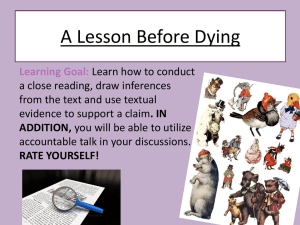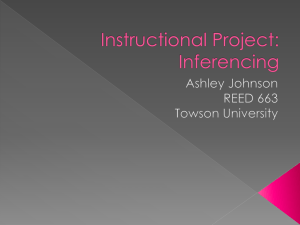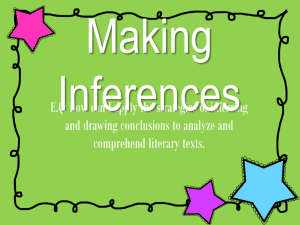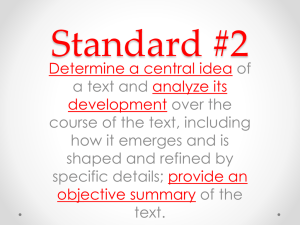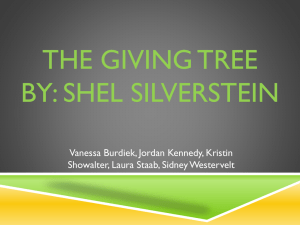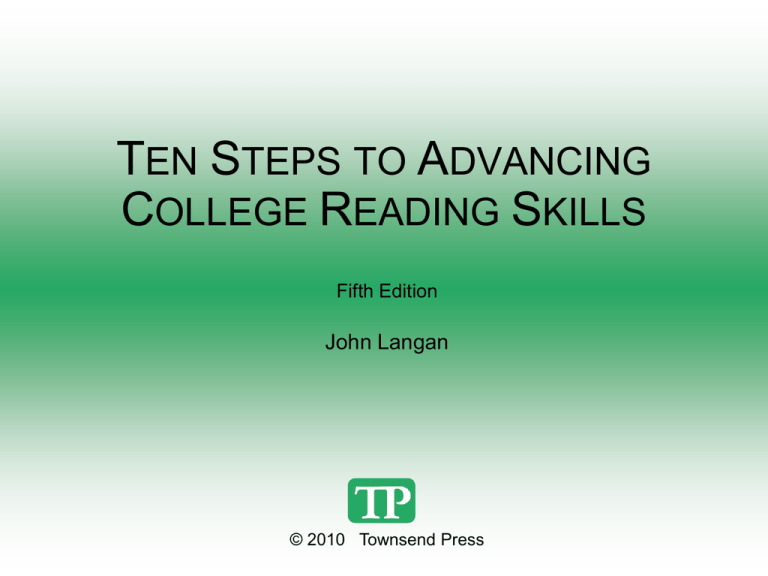
TEN STEPS TO ADVANCING
COLLEGE READING SKILLS
Fifth Edition
John Langan
© 2010 Townsend Press
Chapter Seven:
Inferences
• Many important ideas in reading are not
stated directly.
• Discovering these ideas is called making
inferences or drawing conclusions.
INFERENCES
Which inference is more
logically based on the
information in this cartoon?
A. The man was probably working
on a home improvement or
repair project.
B. The man deliberately ruined the
woman’s pan.
REAL LIFE ADVENTURES © 2008 GarLanco, Reprinted with permission
of UNIVERSAL PRESS SYNDICATE. All rights reserved.
INFERENCES
Which inference is more
logically based on the
information in this cartoon?
A. The man was probably working
on a home improvement or
repair project.
Since the man was using a kitchen pan as a
hammer, he must have been somewhere
where there is a kitchen—probably his and
the woman’s home.
B. The man deliberately ruined the
woman’s pan.
The man’s explanation—he couldn’t find his
hammer—suggests that he simply needed
something to hammer with. Nothing
suggests that he intentionally ruined the
pan.
REAL LIFE ADVENTURES © 2008 GarLanco, Reprinted with permission
of UNIVERSAL PRESS SYNDICATE. All rights reserved.
INFERENCES
Which inference is more
logically based on the
information in this cartoon?
C. The woman is upset that the
man has used her pan as a
hammer.
D. The man realizes that the
woman is angry at him for using
her good pan as a hammer.
REAL LIFE ADVENTURES © 2008 GarLanco, Reprinted with permission
of UNIVERSAL PRESS SYNDICATE. All rights reserved.
INFERENCES
Which inference is more
logically based on the
information in this cartoon?
C. The woman is upset that the
man has used her pan as a
hammer.
The woman’s final comment strongly
suggests that she is angry and needs to let
out her anger, quite possibly by hammering
the person who ruined her pan.
D. The man realizes that the
woman is angry at him for using
her good pan as a hammer.
Nothing in the man’s body language or
words indicates that he realizes the woman
is angry with him.
REAL LIFE ADVENTURES © 2008 GarLanco, Reprinted with permission
of UNIVERSAL PRESS SYNDICATE. All rights reserved.
INFERENCES IN READING
Which inference is more firmly based on the information in the passage?
Jim Johnson panicked when he came home from work to find his neighbor’s pet
rabbit dead and in the jaws of his German shepherd, Fido. Johnson took the filthy,
slightly chewed-up bunny into his house, washed it with care, and then used the blow
dryer to restore its fur as best he could. A short time later he secretly put the rabbit back
into its outdoor cage.
The next day, Jim’s neighbor stopped him as they were both doing yard work.
“Did you hear that Thumper died?”
“Uh, no,” stammered Johnson.
“We went out a couple days ago and found him dead. What’s really weird, though,
is that the day after we buried him, we went outside and discovered that someone had
dug him up, given him a bath, styled his fur, and put him back into his cage!”
A. Johnson’s neighbor had children who took care of the rabbit.
B. Fido had probably dug up the rabbit’s grave.
INFERENCES IN READING
Which inference is more firmly based on the information in the passage?
Jim Johnson panicked when he came home from work to find his neighbor’s pet
rabbit dead and in the jaws of his German shepherd, Fido. Johnson took the filthy,
slightly chewed-up bunny into his house, washed it with care, and then used the blow
dryer to restore its fur as best he could. A short time later he secretly put the rabbit back
into its outdoor cage.
The next day, Jim’s neighbor stopped him as they were both doing yard work.
“Did you hear that Thumper died?”
“Uh, no,” stammered Johnson.
“We went out a couple days ago and found him dead. What’s really weird, though,
is that the day after we buried him, we went outside and discovered that someone had
dug him up, given him a bath, styled his fur, and put him back into his cage!”
A. Johnson’s neighbor had children who took care of the rabbit.
There is no mention of Johnson’s children.
B. Fido had probably dug up the rabbit’s grave.
Since the rabbit had been buried, it is logical to infer that the only
way Fido could have gotten it was to dig it up.
INFERENCES IN READING
Which inference is most firmly based on the information in the passage?
Jim Johnson panicked when he came home from work to find his neighbor’s pet
rabbit dead and in the jaws of his German shepherd, Fido. Johnson took the filthy,
slightly chewed-up bunny into his house, washed it with care, and then used the blow
dryer to restore its fur as best he could. A short time later he secretly put the rabbit back
into its outdoor cage.
The next day, Jim’s neighbor stopped him as they were both doing yard work.
“Did you hear that Thumper died?”
“Uh, no,” stammered Johnson.
“We went out a couple days ago and found him dead. What’s really weird, though,
is that the day after we buried him, we went outside and discovered that someone had
dug him up, given him a bath, styled his fur, and put him back into his cage!”
C. The neighbor was convinced that Johnson had dug up the rabbit.
D. Jim Johnson assumed his dog had killed the rabbit.
E. The rabbit had been very sick.
INFERENCES IN READING
Which inference is most firmly based on the information in the passage?
Jim Johnson panicked when he came home from work to find his neighbor’s pet
rabbit dead and in the jaws of his German shepherd, Fido. Johnson took the filthy,
slightly chewed-up bunny into his house, washed it with care, and then used the blow
dryer to restore its fur as best he could. A short time later he secretly put the rabbit back
into its outdoor cage.
The next day, Jim’s neighbor stopped him as they were both doing yard work.
“Did you hear that Thumper died?”
“Uh, no,” stammered Johnson.
“We went out a couple days ago and found him dead. What’s really weird, though,
is that the day after we buried him, we went outside and discovered that someone had
dug him up, given him a bath, styled his fur, and put him back into his cage!”
C. The neighbor was convinced that Johnson had dug up the rabbit.
The matter-of-fact way the neighbor told Jim about Thumper suggests that
he did not suspect Johnson had anything to do with it.
D. Jim Johnson assumed his dog had killed the rabbit.
Johnson’s efforts to cover up what happened to Thumper imply
that he believed his dog had killed it.
E. The rabbit had been very sick.
There is no suggestion that the rabbit had been sick.
INFERENCES IN READING
Which inference is more firmly based on the information in the passage?
Early one morning, a man was walking along a sandy, deserted beach. At least he thought it
was deserted. As he gazed ahead of him, he noticed that there was another human figure in sight.
It was a boy who kept bending down, picking something up, and throwing it into the sea. He
repeated the movement again and again and again.
As the man drew near, he saw that the sand surrounding the boy was covered with starfish
that had been washed in by the waves. It was these stranded starfish that the boy was throwing
into the water.
“Why are you doing that?” the man asked.
Not pausing, the boy replied, “The tide is going out, and the sun is rising. Soon the heat will
be too much for the starfish, and they will die.”
The man shook his head tolerantly. “My dear boy,” he said. “There are miles of beach and
hundreds, maybe thousands of starfish. You can’t save them all. What you’re doing can’t make a
difference!”
The boy listened politely, then picked up the next starfish and threw it in the water. “It makes
a difference for this one,” he answered.
A. The boy knows he cannot save all the starfish.
B. The man believes the boy’s efforts are admirable.
INFERENCES IN READING
Which inference is more firmly based on the information in the passage?
Early one morning, a man was walking along a sandy, deserted beach. At least he thought it
was deserted. As he gazed ahead of him, he noticed that there was another human figure in sight.
It was a boy who kept bending down, picking something up, and throwing it into the sea. He
repeated the movement again and again and again.
As the man drew near, he saw that the sand surrounding the boy was covered with starfish
that had been washed in by the waves. It was these stranded starfish that the boy was throwing
into the water.
“Why are you doing that?” the man asked.
Not pausing, the boy replied, “The tide is going out, and the sun is rising. Soon the heat will
be too much for the starfish, and they will die.”
The man shook his head tolerantly. “My dear boy,” he said. “There are miles of beach and
hundreds, maybe thousands of starfish. You can’t save them all. What you’re doing can’t make a
difference!”
The boy listened politely, then picked up the next starfish and threw it in the water. “It makes
a difference for this one,” he answered.
A. The boy knows he cannot save all the starfish.
The boy doesn’t show any surprise when the man tells him he can’t save all the starfish.
Also, the boy’s obvious understanding of the shore cycles makes it clear he knows how
few starfish he could save. He indicates he still wants to save the ones he can.
B. The man believes the boy’s efforts are admirable.
The man is “tolerant” of what the boy is doing, but he suggests the boy’s actions are
pointless.
INFERENCES IN READING
Which inference is more firmly based on the information in the passage?
Early one morning, a man was walking along a sandy, deserted beach. At least he thought it
was deserted. As he gazed ahead of him, he noticed that there was another human figure in sight.
It was a boy who kept bending down, picking something up, and throwing it into the sea. He
repeated the movement again and again and again.
As the man drew near, he saw that the sand surrounding the boy was covered with starfish
that had been washed in by the waves. It was these stranded starfish that the boy was throwing
into the water.
“Why are you doing that?” the man asked.
Not pausing, the boy replied, “The tide is going out, and the sun is rising. Soon the heat will
be too much for the starfish, and they will die.”
The man shook his head tolerantly. “My dear boy,” he said. “There are miles of beach and
hundreds, maybe thousands of starfish. You can’t save them all. What you’re doing can’t make a
difference!”
The boy listened politely, then picked up the next starfish and threw it in the water. “It makes
a difference for this one,” he answered.
C. The man decides to help save some of the stranded starfish.
D. The boy believes that a little help is better than nothing.
INFERENCES IN READING
Which inference is more firmly based on the information in the passage?
Early one morning, a man was walking along a sandy, deserted beach. At least he thought it
was deserted. As he gazed ahead of him, he noticed that there was another human figure in sight.
It was a boy who kept bending down, picking something up, and throwing it into the sea. He
repeated the movement again and again and again.
As the man drew near, he saw that the sand surrounding the boy was covered with starfish
that had been washed in by the waves. It was these stranded starfish that the boy was throwing
into the water.
“Why are you doing that?” the man asked.
Not pausing, the boy replied, “The tide is going out, and the sun is rising. Soon the heat will
be too much for the starfish, and they will die.”
The man shook his head tolerantly. “My dear boy,” he said. “There are miles of beach and
hundreds, maybe thousands of starfish. You can’t save them all. What you’re doing can’t make a
difference!”
The boy listened politely, then picked up the next starfish and threw it in the water. “It makes
a difference for this one,” he answered.
C. The man decides to help save some of the stranded starfish.
The man does not indicate that he will help save the starfish.
D. The boy believes that a little help is better than nothing.
The boy’s efforts to save as many starfish as he can indicate that he does believe that a
little help is better than none.
INFERENCES IN READING
Guidelines for Making Inferences in Reading
1 Never lose sight of available information.
As much as possible, base your inferences on facts.
2 Use your background information and
experience to help you in making inferences.
The more you know about a subject, the better your inferences
are likely to be.
3 Consider the alternatives.
Don’t simply accept the first inference that comes to mind.
INFERENCES IN LITERATURE
Inferences are very important in reading literature.
A nonfiction writer might write:
The little boy was in a stubborn mood.
The novelist might write:
When Todd’s mother asked him to stop playing in the yard and come
indoors, he didn’t even look up but shouted “No!” and then spelled it
out, “N…O!”
• Writers of factual material directly state much of
what they mean.
• Writers of fiction show what they mean.
INFERENCES IN LITERATURE
Poetry, especially, by its nature, implies much of its meaning.
For example, read the following poem by Carl Sandburg.
The fog comes
on little cat feet.
It sits looking
over harbor and city
on silent haunches
and then moves on.
Here, Sandburg uses a figure of speech known as a metaphor,
comparing fog to a cat that makes a sudden, silent, almost mysterious
appearance.
INFERENCES IN LITERATURE
A Note on Figures of Speech
• Creative writers often use comparisons known
as figures of speech to imply their meanings.
• The two most common figures of speech are
similes and metaphors.
INFERENCES IN LITERATURE
A Note on Figures of Speech
Simile — a stated comparison, introduced with like,
as, or as if.
The man says that because the
boss chewed him out, he felt
“like a piece of old bubble gum.”
The simile clearly shows that the
man’s feelings have been hurt.
“The boss was really angry about the
suggestion I made. He chewed me
out! I felt like a piece of old bubble
gum!”
INFERENCES IN LITERATURE
A Note on Figures of Speech
Other Examples of Similes
• Many or the players on the football team have arms as big as
tree trunks.
• After I lost my job, my material possessions soon disappeared
like so much dandelion fluff in a wind.
• When my new boyfriend arrived, my parents stared at him as if
he were a cockroach who had just come under the door.
INFERENCES IN LITERATURE
A Note on Figures of Speech
Metaphor — an implied comparison, with like, as,
or as if omitted.
In this cartoon, the boy, Linus, is using a metaphor when he says
that big sisters are “the crab grass in the lawn of life.” He means
that big sisters spoil things and are a nuisance.
PEANUTS reproduced by permission of United Feature Syndicate, Inc.
INFERENCES IN LITERATURE
A Note on Figures of Speech
Other Examples of Metaphors
• From the airplane, I looked down on Manhattan, an
anthill of frantic life.
• Our boss is always a bear on Monday morning.
• My aunt’s home was a pack-rat’s nest of everything she
had collected during her life.
INFERENCES IN TABLES AND GRAPHS
• Just as pictures and reading material require
inferences, so do tables and graphs.
• To infer the ideas presented in tables and
graphs, you must consider all the
information presented.
INFERENCES IN TABLES AND GRAPHS
Steps in Reading a Table or Graph
1 Read the title.
What is the title of the table below?
The Bingeing Phenomenon
Many college students drink heavily;
shown below is the percentage of students in each category who binge.
Race
Participation in Sports
White
48%
Hispanic
33
Nat.Amer./Nat. Alask. 34
Nonparticipant
Participant
Team leader
College residences
Asian/Pacific islander 21
Attitude
Fraternity/sorority
84%
Coed dorm
52
Off-campus
housing 40
______________________
Single-sex dorm
38
African American
Age
Under 21
21-23
24+
45%
48
28
16
36%
54
58
Gender
Frequent bingers who think
they drink lightly/moderately
Male
50%
______________________
Female
39
Male
91%
______________________
Female
38
SOURCES: Harvard School of Public Health, Journal of American College Health
INFERENCES IN TABLES AND GRAPHS
Steps in Reading a Table or Graph
1 Read the title.
What is the title of the table below?
The Bingeing Phenomenon
The Bingeing Phenomenon
Many college students drink heavily;
shown below is the percentage of students in each category who binge.
Race
Participation in Sports
White
48%
Hispanic
33
Nat.Amer./Nat. Alask. 34
Nonparticipant
Participant
Team leader
College residences
Asian/Pacific islander 21
Attitude
Fraternity/sorority
84%
Coed dorm
52
Off-campus
housing 40
______________________
Single-sex dorm
38
African American
Age
Under 21
21-23
24+
45%
48
28
16
36%
54
58
Gender
Frequent bingers who think
they drink lightly/moderately
Male
50%
______________________
Female
39
Male
91%
______________________
Female
38
SOURCES: Harvard School of Public Health, Journal of American College Health
INFERENCES IN TABLES AND GRAPHS
Steps in Reading a Table or Graph
2 Check the source.
What are the sources for the table below?
The Bingeing Phenomenon
Many college students drink heavily;
shown below is the percentage of students in each category who binge.
Race
Participation in Sports
White
48%
Hispanic
33
Nat.Amer./Nat. Alask. 34
Nonparticipant
Participant
Team leader
College residences
Asian/Pacific islander 21
Attitude
Fraternity/sorority
84%
Coed dorm
52
Off-campus
housing 40
______________________
Single-sex dorm
38
African American
Age
Under 21
21-23
24+
45%
48
28
16
36%
54
58
Gender
Frequent bingers who think
they drink lightly/moderately
Male
50%
______________________
Female
39
Male
91%
______________________
Female
38
SOURCES: Harvard School of Public Health, Journal of American College Health
INFERENCES IN TABLES AND GRAPHS
Steps in Reading a Table or Graph
2 Check the source.
What are the sources for the table below?
SOURCES: Harvard School of Public Health, Journal of American College Health
The Bingeing Phenomenon
Many college students drink heavily;
shown below is the percentage of students in each category who binge.
Race
Participation in Sports
White
48%
Hispanic
33
Nat.Amer./Nat. Alask. 34
Nonparticipant
Participant
Team leader
College residences
Asian/Pacific islander 21
Attitude
Fraternity/sorority
84%
Coed dorm
52
Off-campus
housing 40
______________________
Single-sex dorm
38
African American
Age
Under 21
21-23
24+
45%
48
28
16
36%
54
58
Gender
Frequent bingers who think
they drink lightly/moderately
Male
50%
______________________
Female
39
Male
91%
______________________
Female
38
SOURCES: Harvard School of Public Health, Journal of American College Health
INFERENCES IN TABLES AND GRAPHS
Steps in Reading a Table or Graph
3 Read any captions at the top, the side, or underneath
that tell exactly what each column, line, bar, number, or
other item represents.
The Bingeing Phenomenon
Many college students drink heavily;
shown below is the percentage of students in each category who binge.
Race
Participation in Sports
White
48%
Hispanic
33
Nat.Amer./Nat. Alask. 34
Nonparticipant
Participant
Team leader
College residences
Asian/Pacific islander 21
Attitude
Fraternity/sorority
84%
Coed dorm
52
Off-campus
housing 40
______________________
Single-sex dorm
38
African American
Age
Under 21
21-23
24+
45%
48
28
16
36%
54
58
Gender
Frequent bingers who think
they drink lightly/moderately
Male
50%
______________________
Female
39
Male
91%
______________________
Female
38
SOURCES: Harvard School of Public Health, Journal of American College Health
INFERENCES IN TABLES AND GRAPHS
Which inference is more logically based on the table?
A. The older students get, the more they tend to binge.
B. In general, students who live in fraternities or sororities drink
more heavily than students who live elsewhere.
The Bingeing Phenomenon
Many college students drink heavily;
shown below is the percentage of students in each category who binge.
Race
Participation in Sports
White
48%
Hispanic
33
Nat.Amer./Nat. Alask. 34
Nonparticipant
Participant
Team leader
College residences
Asian/Pacific islander 21
Attitude
Fraternity/sorority
84%
Coed dorm
52
Off-campus
housing 40
______________________
Single-sex dorm
38
African American
Age
Under 21
21-23
24+
45%
48
28
16
36%
54
58
Gender
Frequent bingers who think
they drink lightly/moderately
Male
50%
______________________
Female
39
Male
91%
______________________
Female
38
SOURCES: Harvard School of Public Health, Journal of American College Health
INFERENCES IN TABLES AND GRAPHS
Which inference is more logically based on the table?
A. The older students get, the more they tend to binge.
The “Age” section of the table indicates that once students become 24 or older,
their bingeing decreases from 48% to 28%.
B. In general, students who live in fraternities or sororities drink
more heavily than students who live elsewhere.
The “College residences” section of the table tells us that fraternity and sorority
members do drink more heavily than the other three groups.
The Bingeing Phenomenon
Many college students drink heavily;
shown below is the percentage of students in each category who binge.
Race
Participation in Sports
White
48%
Hispanic
33
Nat.Amer./Nat. Alask. 34
Nonparticipant
Participant
Team leader
College residences
Asian/Pacific islander 21
Attitude
Fraternity/sorority
84%
Coed dorm
52
Off-campus
housing 40
______________________
Single-sex dorm
38
African American
Age
Under 21
21-23
24+
45%
48
28
16
36%
54
58
Gender
Frequent bingers who think
they drink lightly/moderately
Male
50%
______________________
Female
39
Male
91%
______________________
Female
38
SOURCES: Harvard School of Public Health, Journal of American College Health
INFERENCES IN TABLES AND GRAPHS
Which inference is more logically based on the table?
C. Bingeing is not popular among college athletes.
D. Most college students who binge are unaware of the true extent
of their drinking.
The Bingeing Phenomenon
Many college students drink heavily;
shown below is the percentage of students in each category who binge.
Race
Participation in Sports
White
48%
Hispanic
33
Nat.Amer./Nat. Alask. 34
Nonparticipant
Participant
Team leader
College residences
Asian/Pacific islander 21
Attitude
Fraternity/sorority
84%
Coed dorm
52
Off-campus
housing 40
______________________
Single-sex dorm
38
African American
Age
Under 21
21-23
24+
45%
48
28
16
36%
54
58
Gender
Frequent bingers who think
they drink lightly/moderately
Male
50%
______________________
Female
39
Male
91%
______________________
Female
38
SOURCES: Harvard School of Public Health, Journal of American College Health
INFERENCES IN TABLES AND GRAPHS
Which inference is more logically based on the table?
C. Bingeing is not popular among college athletes.
The “Participation in sports” section shows that 54% of college athletes and
58% of team leaders binge.
D. Most college students who binge are unaware of the true extent
of their drinking.
The “Attitude” section shows that most male and female bingers believe they drink
only lightly or moderately.
The Bingeing Phenomenon
Many college students drink heavily;
shown below is the percentage of students in each category who binge.
Race
Participation in Sports
White
48%
Hispanic
33
Nat.Amer./Nat. Alask. 34
Nonparticipant
Participant
Team leader
College residences
Asian/Pacific islander 21
Attitude
Fraternity/sorority
84%
Coed dorm
52
Off-campus
housing 40
______________________
Single-sex dorm
38
African American
Age
Under 21
21-23
24+
45%
48
28
16
36%
54
58
Gender
Frequent bingers who think
they drink lightly/moderately
Male
50%
______________________
Female
39
Male
91%
______________________
Female
38
SOURCES: Harvard School of Public Health, Journal of American College Health
CHAPTER REVIEW
In this chapter, you learned the following:
• Many important ideas in reading are not stated directly but must be
inferred. To make inferences about implied ideas, use the information
provided as well as your own experience and logic.
• Inferences are also a key part of reading literature and such visual
material as cartoons, tables, and graphs.
The next chapter—Chapter 8—will help make you aware of an author’s
purpose and tone.

